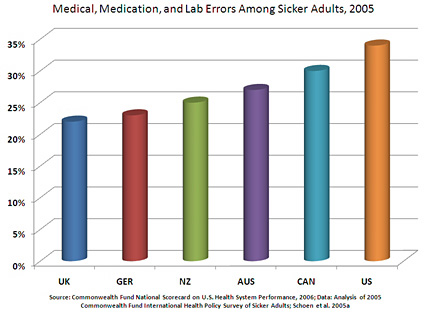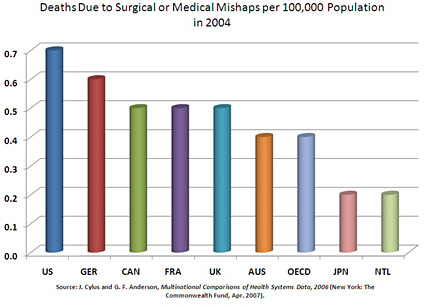 |
 |
 |

November / December 2007

Technology and Quality
Revolutionary HIT:
Cure for Insanity
By Barry P. Chaiken, MD, MPH, FHIMSS
Whether as individuals, businesses, or government, we collectively spend great sums on care delivery yet obtain relatively low value in return. While the U.S. spends close to 17% of GDP on healthcare, a report published by the California Healthcare Foundation in May 2007 showed that we ranked last or next to last on 9 of 10 measures of healthcare delivery. On the measure of medical errors, we ranked last among six countries with 34% of patients "receiving" a medical error (Figure 1). As for deaths due to surgical or medical mishaps, the U.S. experienced about 75% more deaths than the average OECD country (Figure 2). Only on the quality measure "Safe Care" did the U.S. receive a high ranking (Davis et al., 2007).




Are We Insane?
Don Berwick, MD, an international leader in healthcare quality improvement observed that "every system is perfectly designed to get the results it gets." Building on Dr. Berwick's notion, other experts have defined insanity as doing the same thing over and over again and expecting different results.
Perhaps for some of us, deployment of healthcare IT is our expression of insanity. Many organizations, led by dedicated and intelligent professionals, successfully implement — as defined by technical specifications — a variety of healthcare information systems only to discover that their process and outcomes measures change little. Unfortunately, without changing the underlying processes and workflows that existed before the implementation of healthcare IT, little change in those measures should be expected.
Time for a Revolution
Revolution is defined as a "drastic and far-reaching change in ways of thinking and behaving." Our healthcare system requires a health information technology (HIT) revolution, a drastic change in the way we deliver care by utilizing IT in new and innovative ways. Aggressively deploying IT, to replicate the processes and workflows that currently deliver our poor results on so many measures, only guarantees continued suboptimal and unacceptable outcomes.
Touted as a source of great efficiency and effectiveness, information technology currently offers limited healthcare examples of significant and documented gains. Considering the millions of dollars spent on healthcare IT by organizations around the country, these results are quite discouraging.
To best understand why our gains from IT investments have not materialized, let's look to other industries as models. Across many industries that deployed IT, a lag period occurred where quality and costs savings did not appear. As frustrating as this period was, companies that continued to invest in IT slowly began to experience the jumps in productivity and profit that were long expected. Each organization reached a tipping point where processes and workflow evolved to take advantage of the new IT tools to deliver unprecedented results.
To look at the benefit of IT on these companies in isolation is to miss the true lesson to be gained from their experiences. Early on, the deployment of IT was viewed as the solution. Only after companies recognized it to be just a tool, did they formulate the real solutions based upon revised processes and flow, which then provided much of the benefits.
Focus on Three Key Areas
Revolutionary HIT requires a focus on three key areas: 1) processes and workflows, 2) information technology tools, and 3) healthcare provider tasks, duties and responsibilities.
Solutions come from an in-depth understanding of tools, and creative thinking around what healthcare professionals can do and how best to use their individual skill. Bringing together experts in clinical medicine, information technology, and process redesign creates an environment where the best processes and workflows effectively leverage the new HIT tools. Such diverse working groups allow meaningful knowledge transfer and the development of solutions that transcend the expertise inherent in each silo of knowledge.
Valued solutions offer these professionals HIT tools that leverage their unique skills, while organizing the processes and workflows to deliver a consistently high quality, safe, and efficient healthcare outcome.
Can We Change?
Inherent in revolutionary HIT is the need for change; change in what professionals do and how they do it. Therefore, effective change management techniques must be utilized to facilitate the acceptance of the new processes and workflows, in addition to any new responsibilities and duties.
Currently, patient delivery relies upon an unreliable system of poorly integrated and highly variable healthcare professionals. Revolutionary HIT solutions provide needed support tools that increase the reliability of the human components, while integrating these components through effective processes and efficient workflows.
Revolutionary HIT fundamentally changes what physicians, nurses, and other healthcare professionals do. Physician activities become more challenging on a cognitive level as other routine tasks such as drug dose recall, use of best practice order sets, and drug-allergy checking become automated. Physician expertise is assigned to more important tasks including solving difficult diagnostic problems, devising customized patient treatment plans, and influencing patient adherence to chronic disease care regimens.
Work for nurses and other healthcare professionals changes dramatically too. More tasks, formerly done by physicians or healthcare specialists, are completed by these professionals guided by intelligent processes and workflows that include meaningful HIT.
Revolutionary HIT places the right professional, with the right knowledge, in the right process, utilizing the right workflow to deliver the best evidence-based care to the patient. Care delivery is focused on the patient and their needs rather than the requirements of unchanged, ineffective workflows established before the dawn of information technology.
For information technology to play a valuable role in reducing healthcare costs while enhancing quality of care, it must be deployed in a revolutionary way that completely reinvents how care is delivered, professionals provide the care, and technology is leveraged throughout care delivery. Without such a revolution, the billions of dollars currently being invested in healthcare IT will have little positive impact on our health.
Barry Chaiken has more than 20 years of experience in medical research, epidemiology, clinical information technology, and patient safety. As founder of his own company, he has worked on quality improvement studies and clinical investigations for the National Institutes of Health, Framingham Heart Study, and Boston University Medical School. Chaiken is board certified in general preventive medicine and public health and is a Fellow and Board Member of HIMSS. He is the associate chief medical officer of BearingPoint, Inc., adjunct assistant professor in the Department of Public Health and Family Medicine at Tufts University School of Medicine, and serves on the Editorial Advisory Board for Patient Safety and Quality Healthcare. He may be contacted at bchaiken@docsnetwork.com.
References
Davis, K., Schoen, C., Schoenbaum, S. C., Doty, M.M., Holmgren, A. L., Kriss, J. L., & Shea, K. K. (2007, May). Mirror, mirror on the wall: An international update on the comparative performance of American health care. The Commonwealth Fund. Available at www.commonwealthfund.org/publications/
publications_show.htm?doc_id=482678.
Chaiken, B. P. (2005). Path innovation: Transcending automation. Patient Safety and Quality Healthcare, 2(3), 46-47.
Chaiken, B. P. (2007). Patient flow: a powerful tool that transforms care. Patient Safety and Quality Healthcare, 4(3), 6-7.
|
 |
 |
 |


















|
 |



